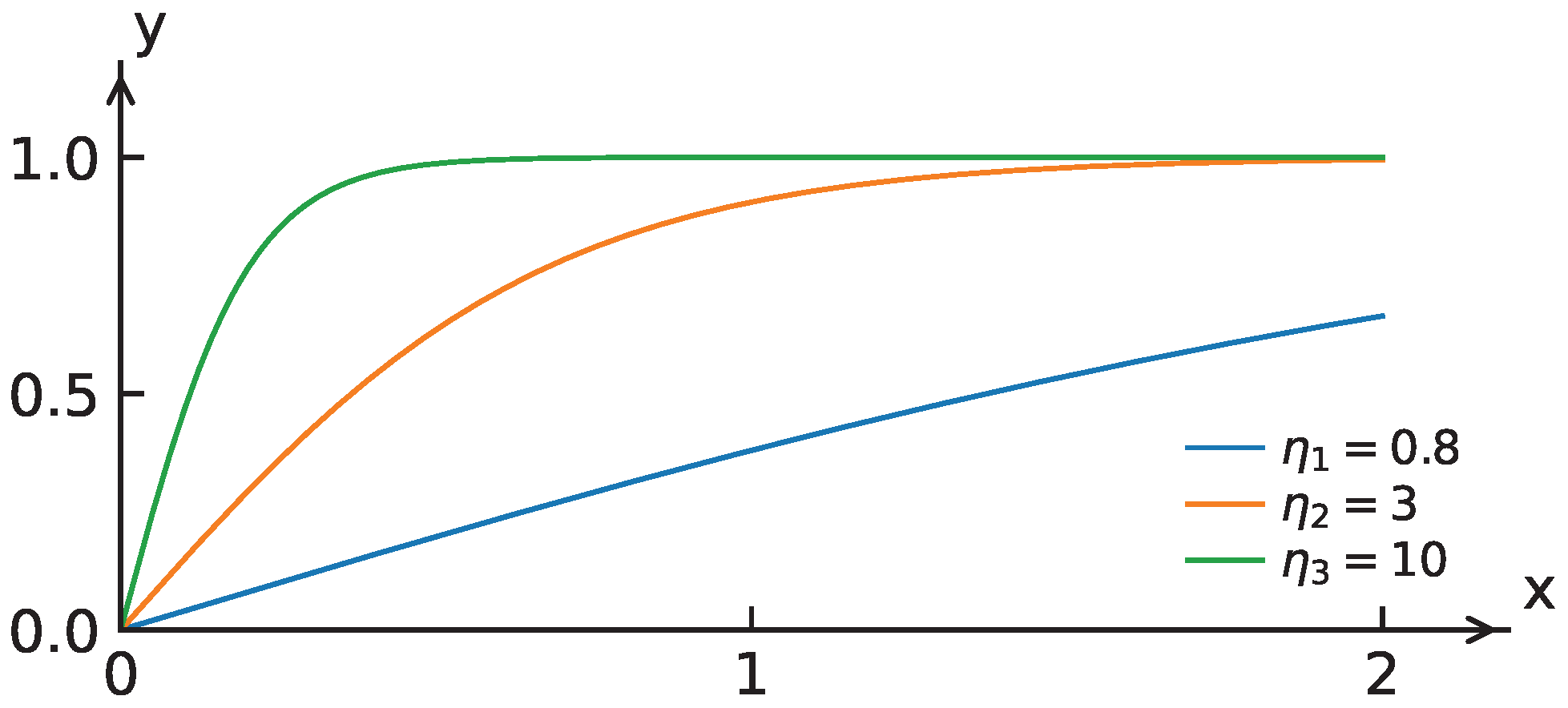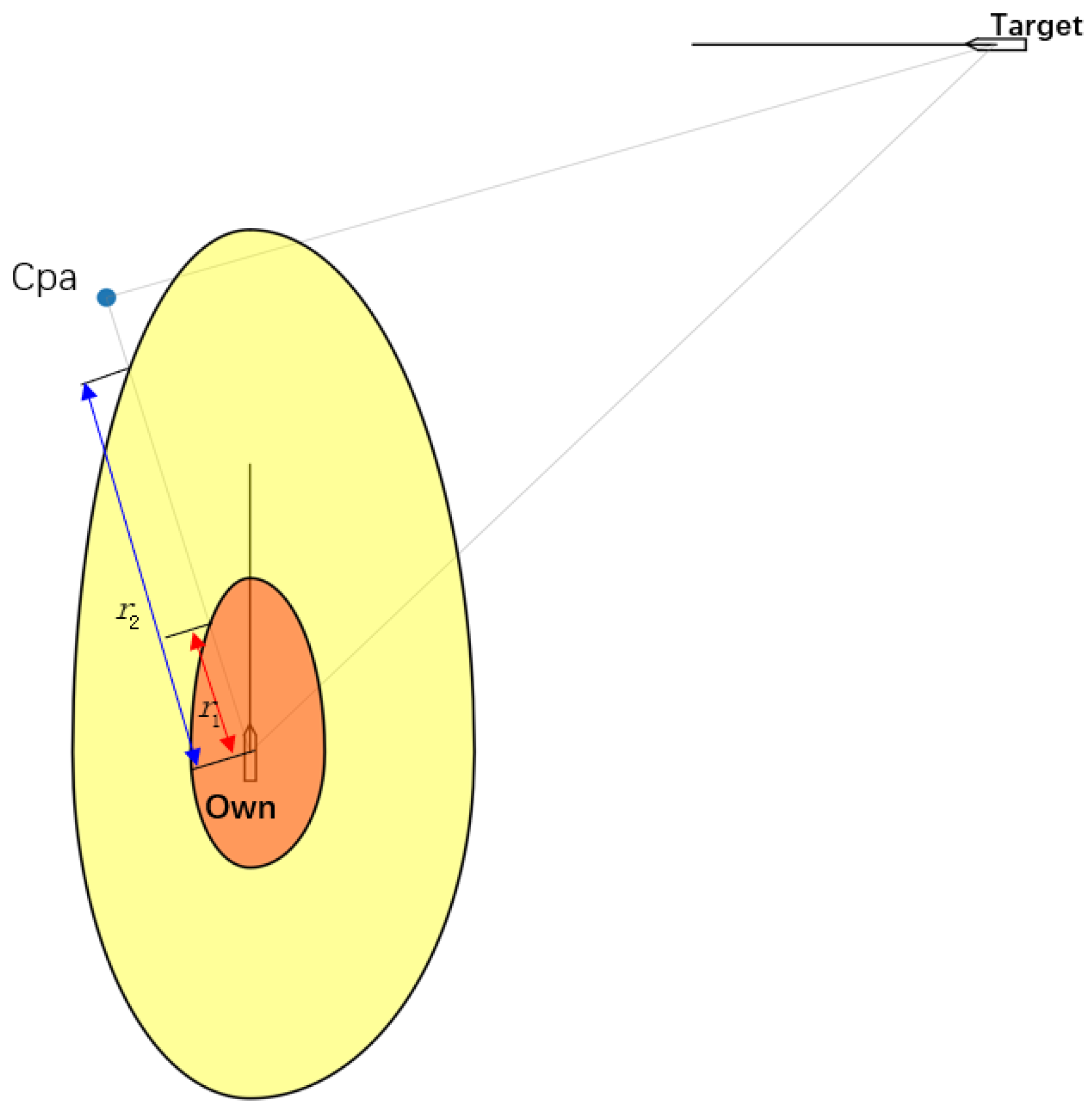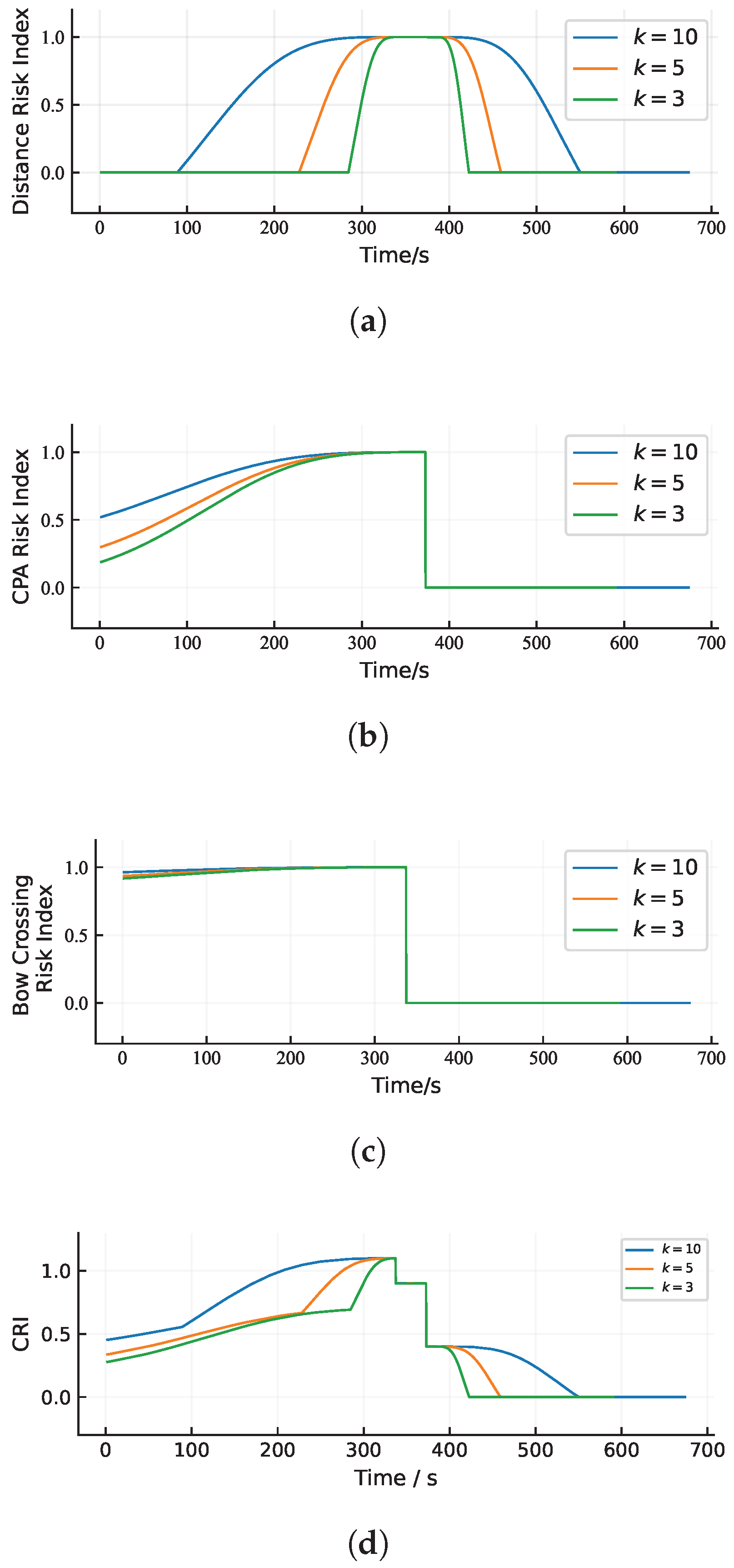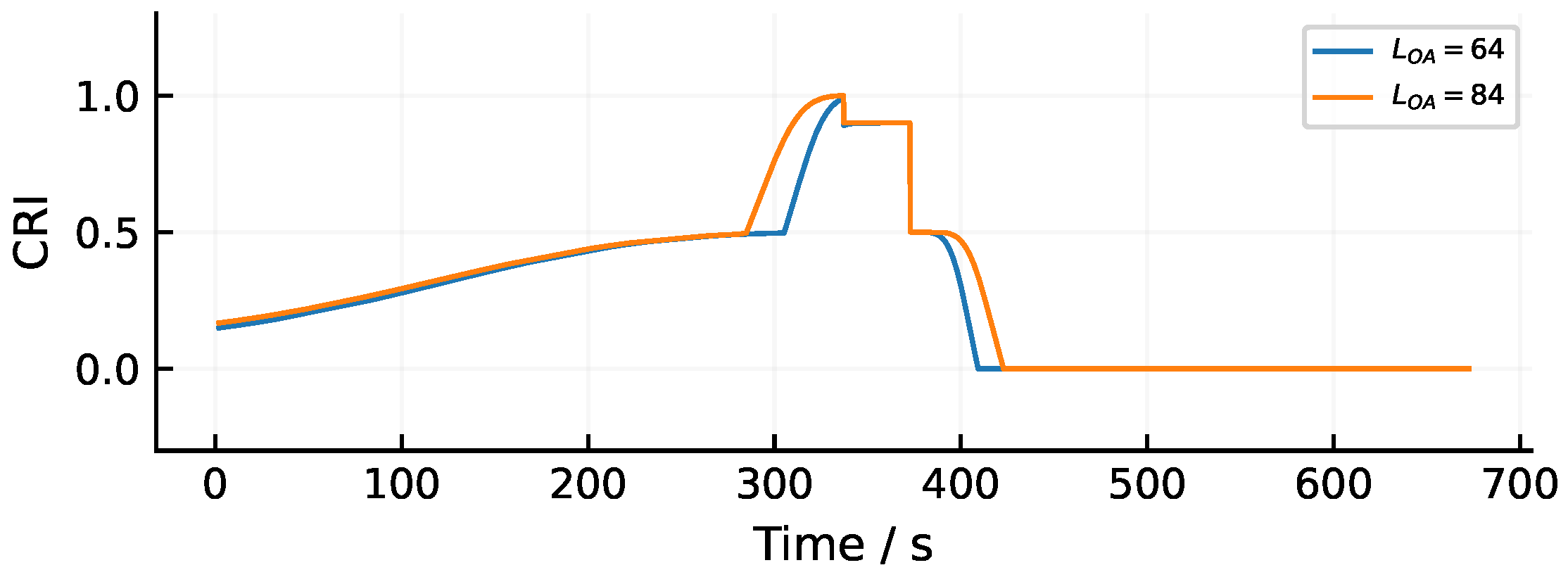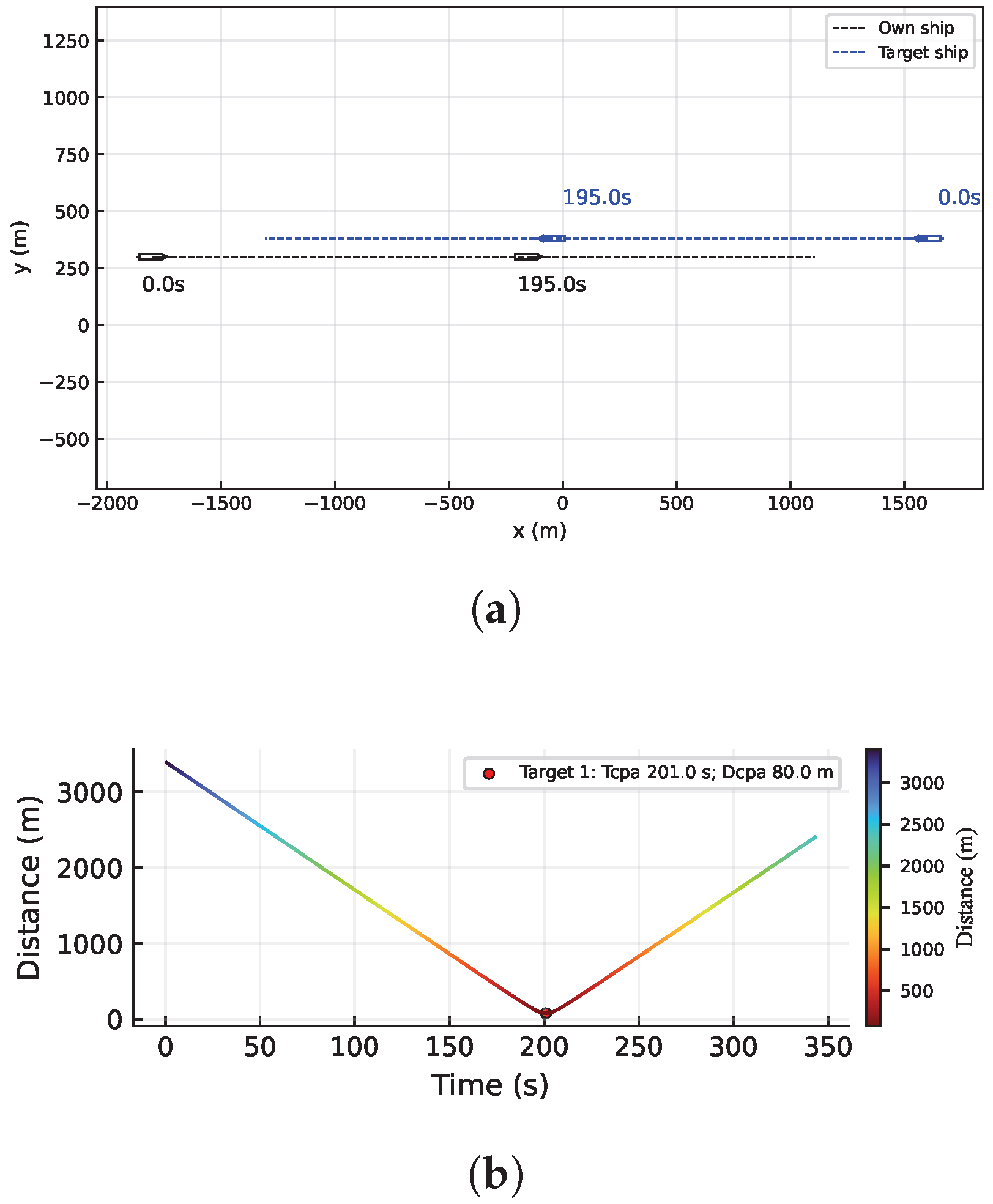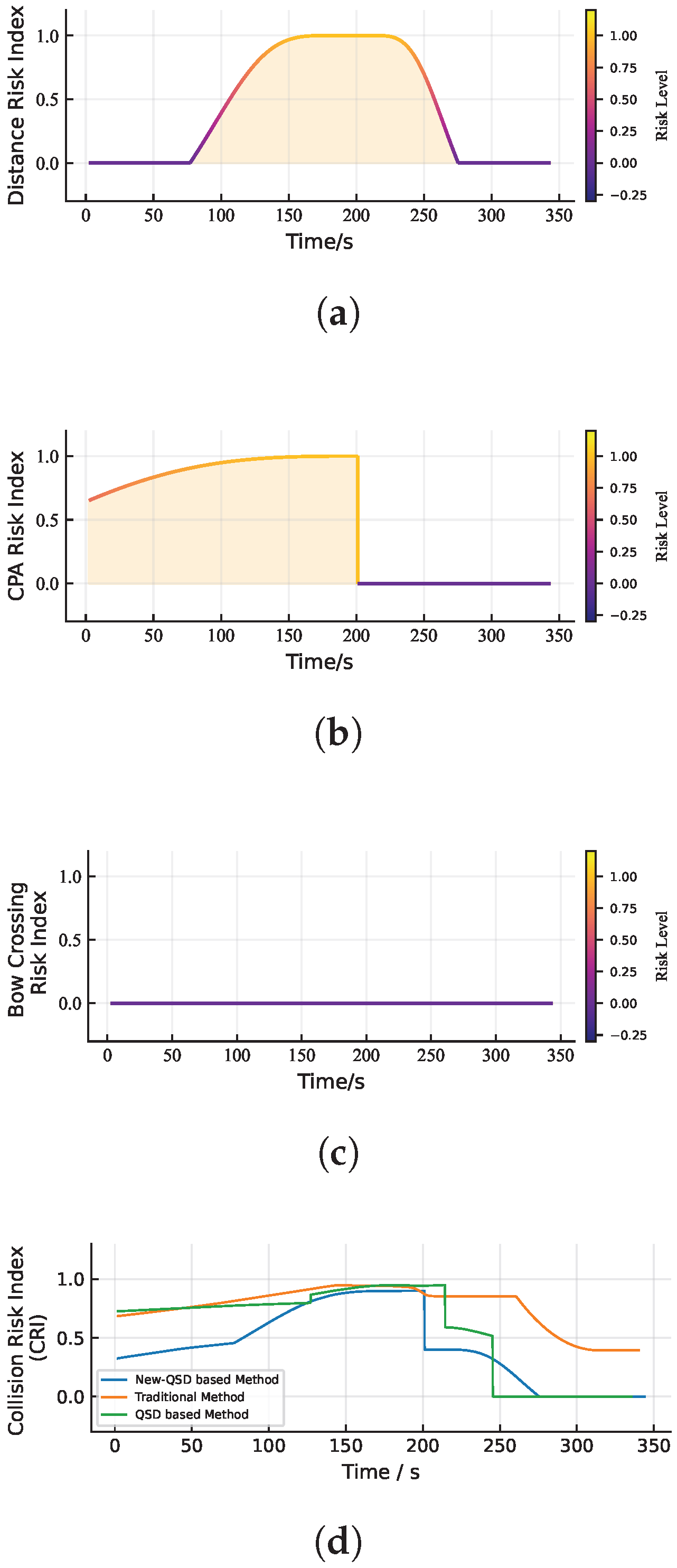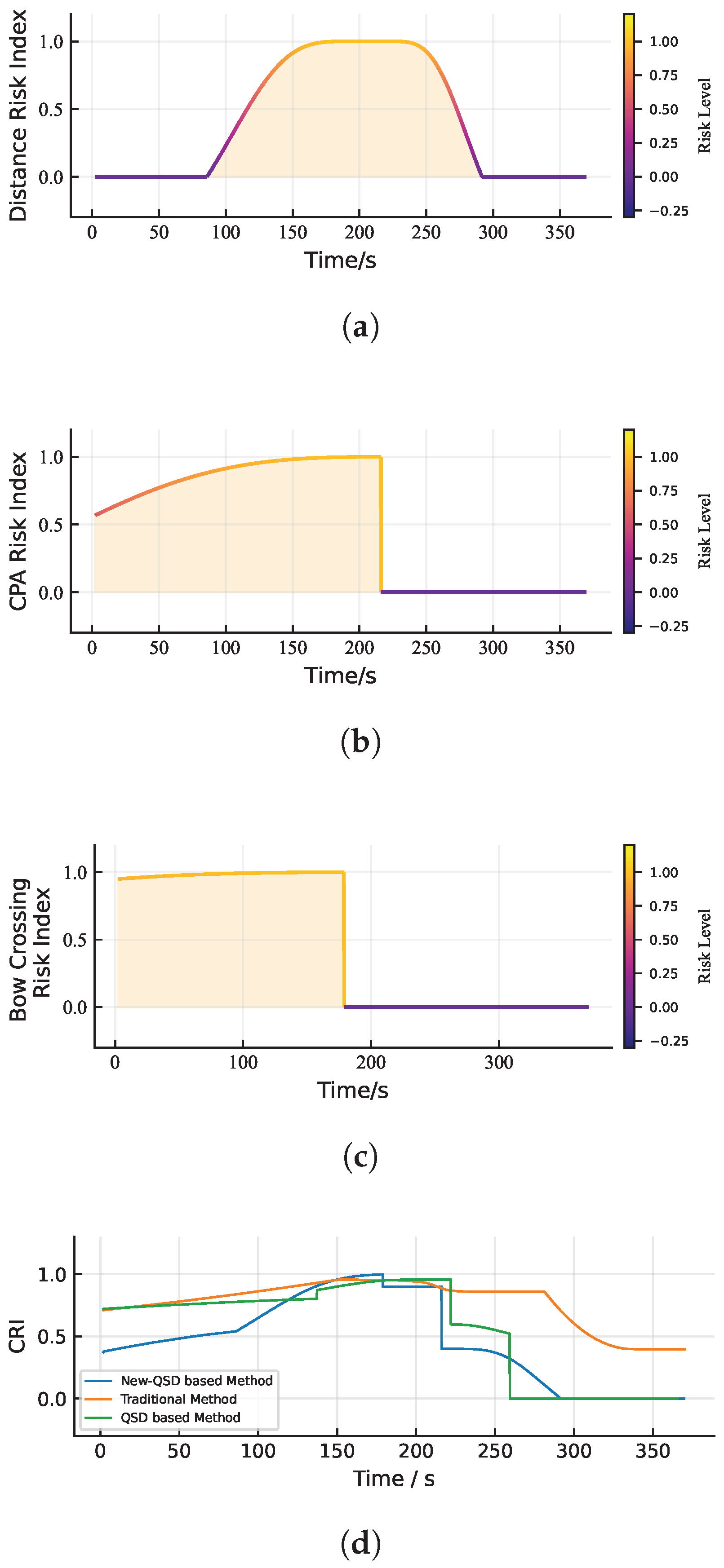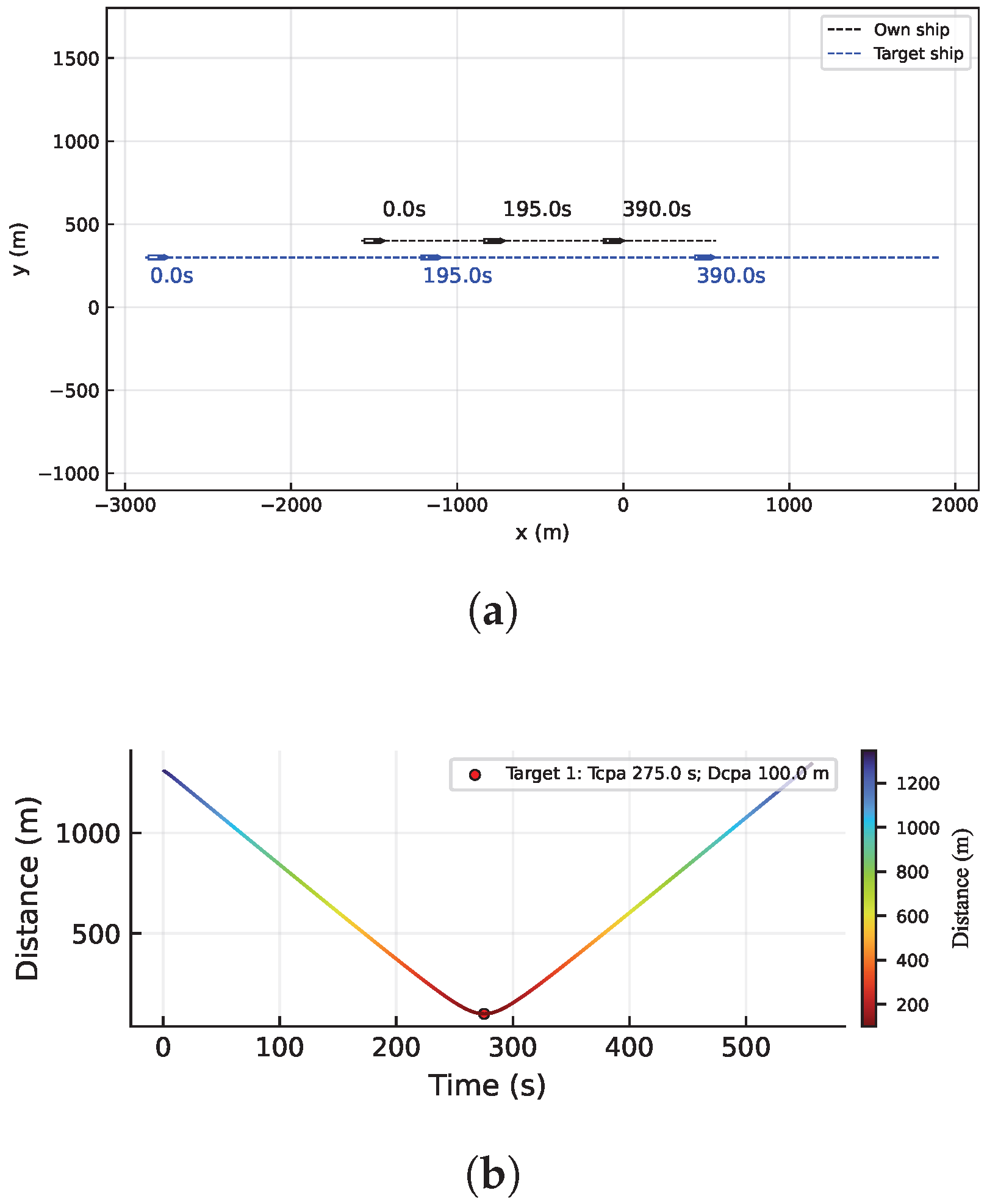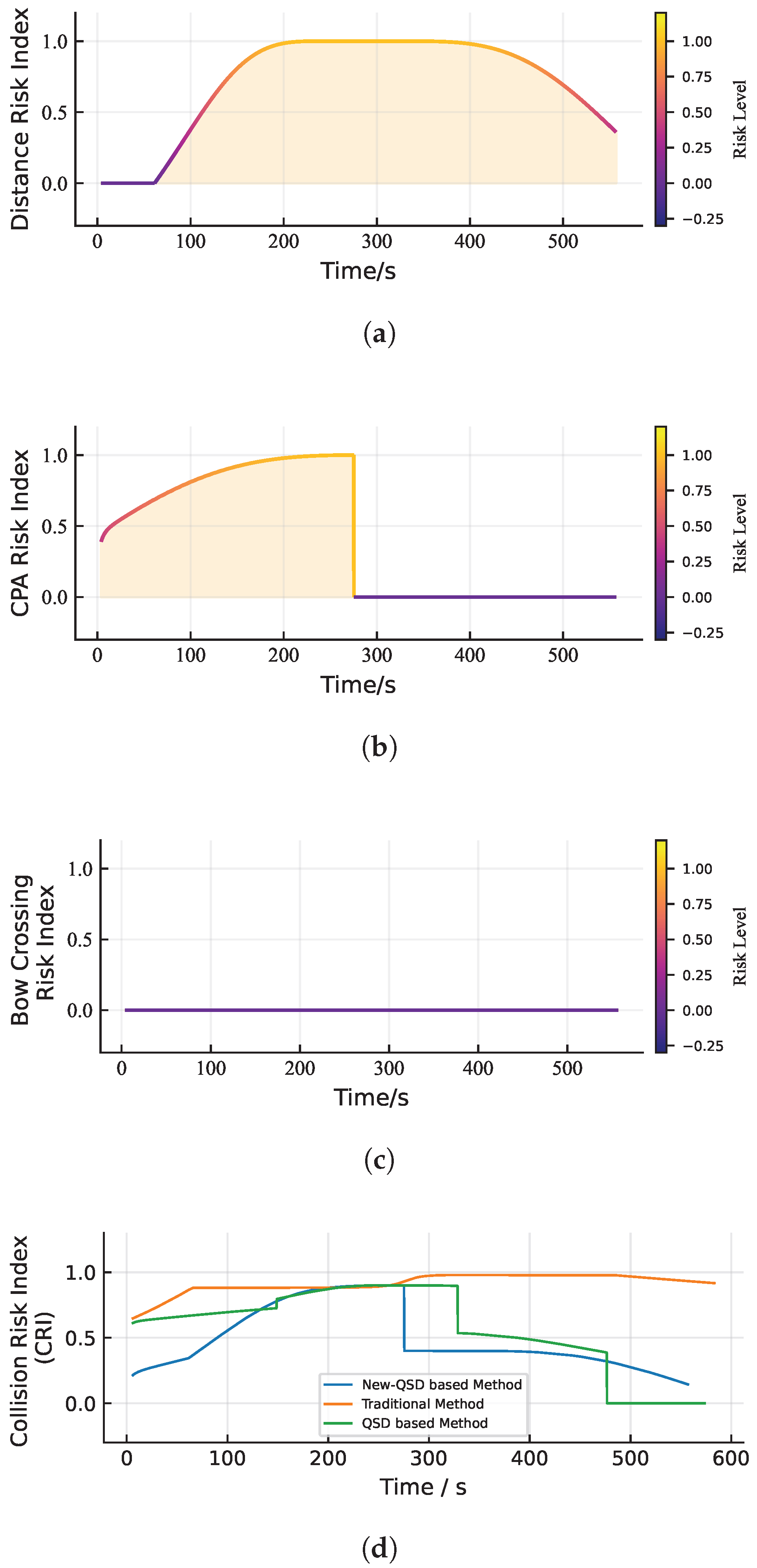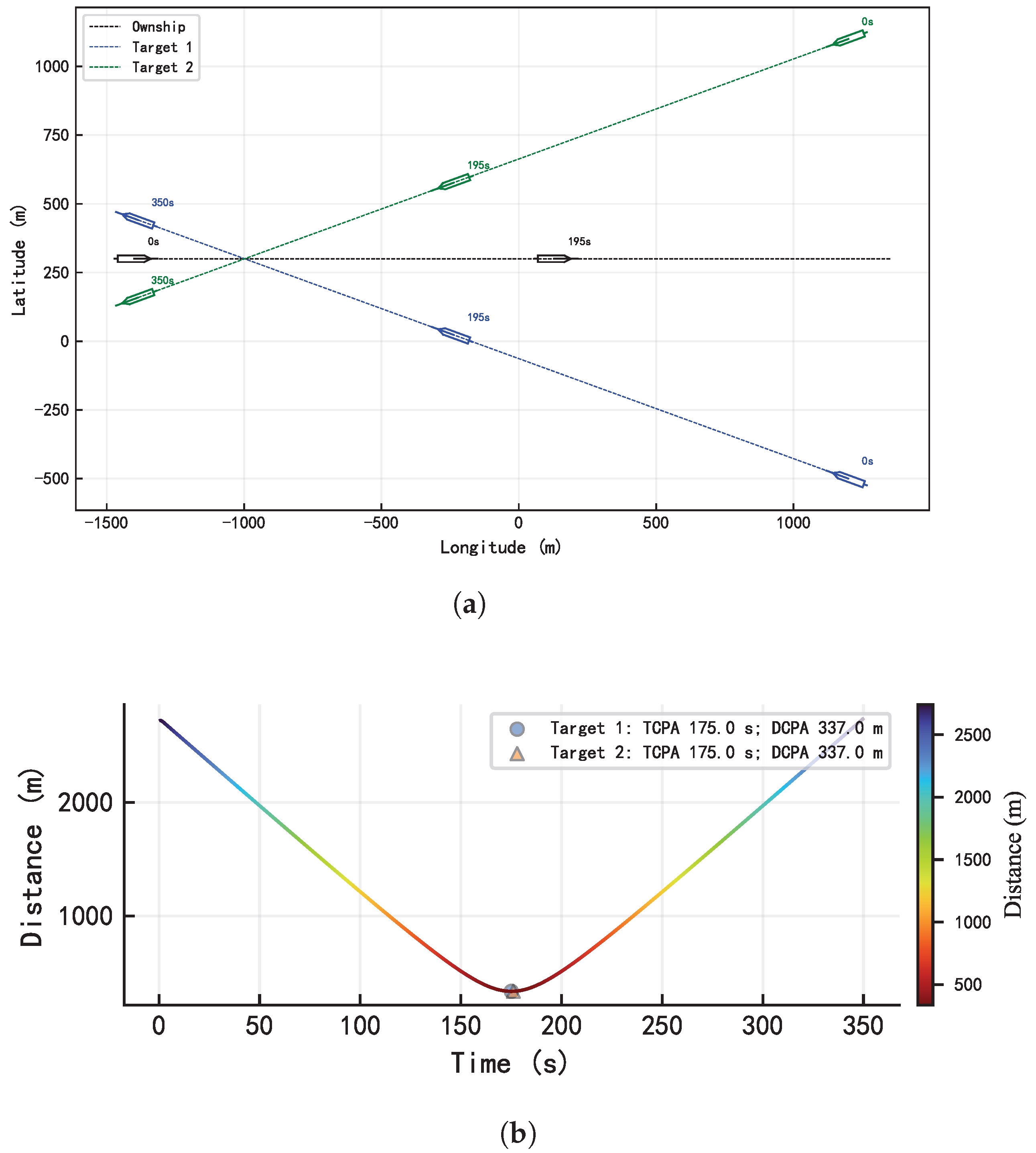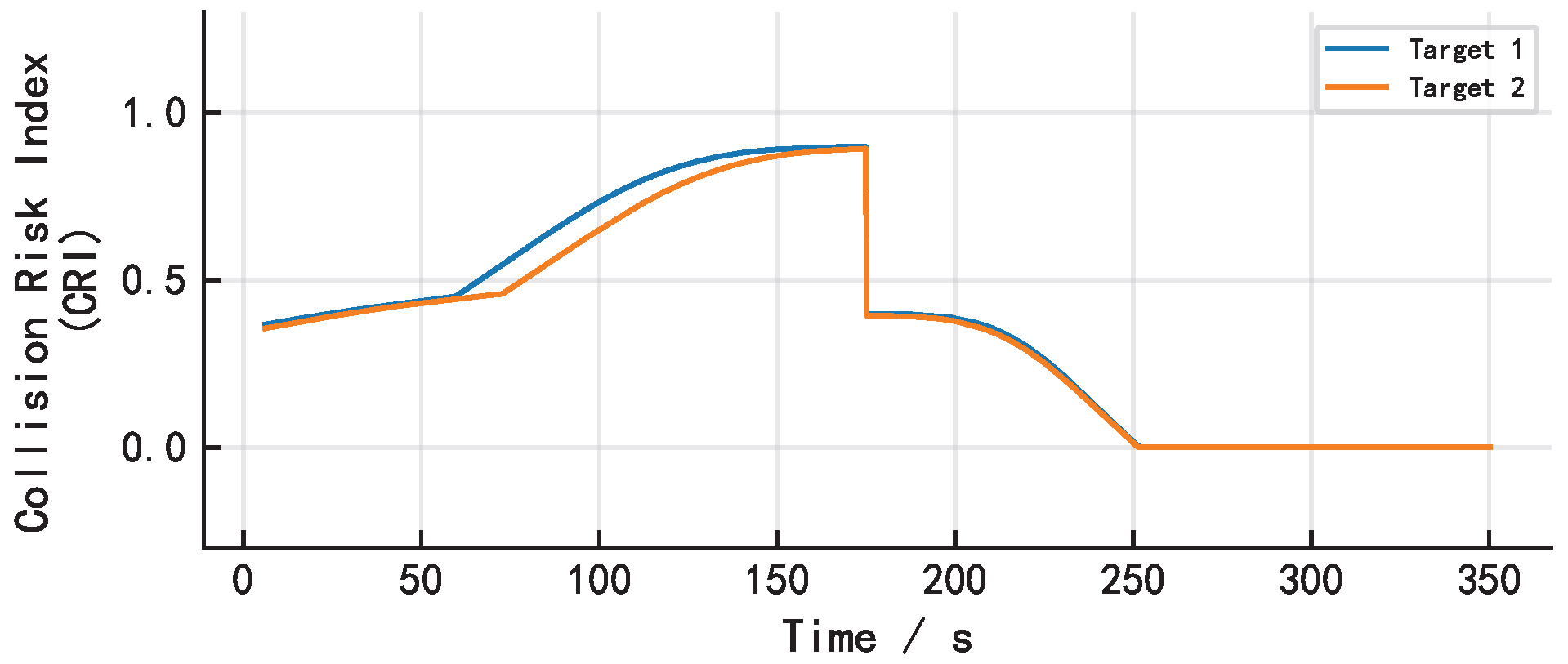2.1. Problem Formulation and Basic Concepts
In this work, we use several key variables such as DCPA, TCPA, distance, BCR, and BCT of obstacles or target ships [
33]. In ASV encounter situations, there are two vessels; one is own ship, the other is the target ship, as shown in the following figure.
Figure 1: “O” denotes own ship; “T” denotes target ship;
denotes the distance between the O and T;
denotes DCPA;
denotes BCR;
denotes the angle from the true bearing line of own ship to the relative velocity vector.
represents the relative bearing of the target ship with respect to own ship; other parameters are calculated as in the following equations.
denotes the velocity vector of the target ship relative to own ship,
is the velocity vector of the own ship, and
is the velocity vector of the target ship.
The DCPA and TCPA between the own ship and the target ship are calculated as follows:
In these equations,
is the course of relative velocity vector
,
represents the true bearing of the target ship from own ship. The distance and time for the target ship passing ahead of own ship are calculated as follows:
In the above equations, denotes BCR, the distance of the target ship passing ahead of own ship, and denotes BCT, the corresponding passing time.
In the process of the ASV avoiding target vessels or obstacles, the key indicators commonly considered are DCPA and TCPA. A smaller DCPA indicates a higher level of danger, while a smaller TCPA reflects greater urgency and, thus, a higher risk. However, using these two indicators independently may lead to biased evaluations. For instance, when DCPA is large but TCPA is small, DCPA suggests a low risk while TCPA indicates high urgency. The combined result may be interpreted as moderate risk, which does not accurately reflect the actual situation. In practice, when DCPA is large, both indicators become less relevant for risk assessment.
Traditional methods often rely on five independent indicators, DCPA, TCPA, distance, relative bearing, and speed ratio, to construct a coupled ship collision index. Such coupling, however, is complex and prone to introducing bias due to the large number of indicators. To simplify the evaluation process and reduce coupling induced deviations, this study adopts only three indices: and .
Moreover, factors such as relative speed and bearing are already embedded in the calculation of TCPA and the QSD. Therefore, they are not separately included in the evaluation system. Instead, this study emphasizes the distance and time of the target ship passing ahead of the own ship, which are critical in practical collision avoidance. A shorter passing distance combined with a shorter passing time indicates higher urgency and, consequently, a greater risk.
Based on this analysis, the collision risk evaluation index system proposed in this study is structured as follows:
Here, represents a composite index of DCPA and TCPA, denotes the inter ship distance, and represents a composite index of BCR and BCT. The construction of these indices relies on encounter-related parameters of the ASV.
2.2. Ship Collision Risk Index Design via Logarithmic–Sigmoid Mapping
This study proposes a ship collision risk index model based on the coupling of the logarithmic and the sigmoid functions. First, when the base of the logarithmic function is less than one, it exhibits the following property: As the independent variable decreases and approaches zero, the function value increases rapidly, with the variation becoming more pronounced near the limit point. This characteristic effectively reflects the real situation in ship encounters, where the risk of collision rises sharply when the inter-ship distance or other critical safety parameters (e.g., TCPA, DCPA) approach their thresholds. Second, the sigmoid functions is widely applied in engineering and machine learning, and its mathematical model is expressed as follows:
In the above equation, denotes the constant weight of input variable and denotes the values of sigmod function value. The curve of this function is as below.
As shown in
Figure 2, the function’s shape is governed by
: A larger
produces a steeper curve (greater gradient). Therefore, when collision risk (
y) needs to respond more sensitively to the input (
x),
should be increased. And the sigmoid function demonstrates a typical S-shaped characteristic, with its output constrained within the interval [0, 1]. This enables the mapping of continuous variables into normalized risk probability values. Such a property is highly consistent with the requirements of ship collision risk assessment: The risk index remains close to 0 under low-risk conditions, while approaching 1 under high-risk conditions.
Accordingly, the proposed risk index model operates as follows: Key encounter parameters (such as distance, relative velocity, and TCPA/DCPA) are first processed through the logarithmic function, leveraging its “critical approach and sharp increase” property for preliminary risk amplification. The output of the logarithmic function is then fed into the sigmoid function, which normalizes the result into the [0, 1] range, producing the final ship collision risk index.
This coupled model not only captures the sharp variation of risk near critical thresholds but also ensures that the resulting values are standardized and highly interpretable, thereby providing a reliable basis for ship collision avoidance decision-making.
2.2.1. Membership Function of Distance
The QSD is a vessel safety zone model that adapts to a ship’s dynamic parameters. Its core concept is to partition the surrounding safety area into four independent sectors—forward, after, port, and starboard—while incorporating shape control parameters to accommodate different navigation cases. In practice, the QSD is derived from vessel navigation habits and statistical analysis of AIS data, which inherently reflect the International Regulations for Preventing Collisions at Sea (COLREGs). Thus, the QSD represents a safety domain that integrates both regulatory requirements and practical maneuvering behavior. In operational cases, vessels in the starboard forward quadrant typically require a wider safety boundary, corresponding to the higher priority of potential collision risks.
In this study, the QSD serves as the basis for reconstructing a collision risk index model for USVs. The QSD boundaries are defined in a Cartesian coordinate system with the ship at the origin, the bow aligned along the positive y-axis, and the starboard direction along the positive x-axis, expressed as follows:
In the above equation, the
function determines the sign of a parameter and is defined as follows:
Similarly, the function is defined. The details of the QSD are as follows.
In
Figure 3,
and
denote the forward and after radian of the QSD along the longitudinal direction, while
and
denote the port and starboard radian along the lateral direction. Their expressions are as follows:
In the equations,
L denotes the length of the own ship;
is the near-distance index, and
is the index for the initial turning radius. Both indices can be estimated from empirical relationships using the ship’s principal dimensions and speed (see [
31,
34]). The QSD defined above delineates a danger zone around the vessel into which other ships are prohibited from entering.
The own ship has two quaternion domains: The larger one represents the ship detection zone, and the smaller one represents the danger zone. When the target ship enters the larger detection zone, collision risk assessment between the ships begins. The position of the own ship (Own) is
, and the position of the target ship (Target) is
. The distance between the ships
is calculated as follows:
In the equation,
a and
b represent the major and minor axes of the QSD, and
denotes the relative bearing of the target ship with respect to the own ship. The specific expressions are as follows:
The maximum value for distance measurement,
, represents the threshold below which the presence of the target ship is considered to pose a risk. Its expression is as follows:
Here, k is a proportional constant that reflects the maneuverability of the own ship, the danger level of the surrounding environment, and the skill of the navigator. In general, for ships with lower maneuverability, higher classification, or operating in high-risk environments, a larger k is adopted to account for the increased collision potential. Traditional distance-based collision assessment methods often fail to capture these practical considerations comprehensively. By contrast, the QSD provides a more realistic and objective representation of the ship’s navigable and danger zones in real time. Therefore, in this study, the proportional constant k is incorporated within the QSD framework to develop a collision risk index that is better aligned with engineering practice and operational realities.
The distance membership function is then constructed as follows:
In the above equations, is a logarithmic function of the inter-ship distance d, serving as the input to the sigmoid function, which ultimately yields the value of the distance membership function . The parameter in the sigmoid function is a hyperparameter that adjusts the sensitivity of the risk assessment.
2.2.2. Membership Functions of DCPA and TCPA
The ship domain constructed based on the aforementioned quaternion ship model is designed to exclude the intrusion of other vessels. Accordingly, the minimum encounter distance should be located outside the QSD, while the boundary distance must also be considered.
As shown in
Figure 4, if the point of
lies within the ship domain, the collision risk index increases;
denotes the minimum threshold distance of the ship domain. At the same time, the maximum safe boundary distance
should also be taken into account. Moreover, the relative bearing of the
with respect to the own ship (Own) is also considered. Thus, the ship domain can be formulated as expressed in the following equations.
In this equation,
a and
b (as in Equation (
16)) are the major and minor axes of the QSD. After determining the CPA point, its true bearing
is obtained as same as
in Equations (
18) and (
19).
Similarly,
. Here,
k is a hyper-parameter, which can be adjusted by increasing or decreasing its value according to actual conditions. For instance, when navigating in restricted waters without changing the voyage plan,
k should be reduced to ensure timely and effective avoidance. Accordingly, the overall membership function of the minimum distance to the closest point of approach and the minimum time to the closest point of approach is constructed as follows:
In the equation, represents the comprehensive membership function for the closest encounter risk of the target vessel; and denote the DCPA and TCPA, respectively. and represent the allowable distance and time thresholds. When the TCPA of the target vessel exceeds , it indicates that sufficient time is available for maneuvering, and the risk membership value becomes 0. Thus, is determined based on the seaman’s skill level or environmental conditions, with s set for this study. Similarly, when the DCPA of the target vessel exceeds , the encounter risk membership function value is also 0.
2.2.3. Membership Functions of BCR and BCT
From the perspective of ship handling practice, seafarers often pay close attention to the BCR and BCT. When the target vessel crosses the bow of the own ship, indicated by a positive BCR value, the collision risk increases as both BCR and BCT decrease. Based on this consideration, this study establishes the membership functions of BCR and BCT as follows.
In these equations, represents the comprehensive membership function of the target vessel’s bow-crossing risk; and denote BCR and BCT, respectively. and represent the allowable maximum bow-crossing distance and time threshold, while denotes the relative velocity of the target vessel. When the bow-crossing time exceeds , it indicates that sufficient time remains for safe passing and, thus, the risk membership value is 0. Similarly, when the bow-crossing distance exceeds the maximum allowable distance , the value of the bow-crossing risk membership function is 0.
2.3. Aggregation into a Comprehensive Collision Risk Index
After calculating the above membership functions, the ship collision risk index can be determined. The construction process of the ship collision risk index in this study is illustrated as follows.
Based on
Figure 5, the autonomous vessel acquires the dynamic information of target ships through sensors such as radar, positioning systems, gyro-compass, and AIS, and combines this with its own static and dynamic information. This allows the calculation of the target vessel’s motion parameters, including DCPA, TCPA, and distance to the target vessel, as well as BCR and BCT.
Using the QSD rules planned for the own ship, which incorporate maneuvering and speed related characteristics, the system further checks whether the distance to the target vessel falls within the detection domain. If it does, the distance membership function value is calculated using logarithmic–sigmoid mapping, such as in Equations (
21) and (
22); otherwise, the membership value is set to 0, while continuously monitoring the inter-ship distance.
Similarly, based on the
distance and direction, the system determines whether this distance lies within the quaternion detection domain. If it does, the membership function of the
distance (
) is calculated using DCPA and TCPA by using logarithmic–sigmoid mapping, such as in Equations (
24) and (
25); otherwise, the membership value is 0, with continuous monitoring of DCPA.
Likewise, using the BCR and BCT, the bow-crossing membership function
is obtained using logarithmic–sigmoid mapping, such as in Equations (
26) and (
27). Finally, the overall distance membership function (
) is integrated. The collision risk index (CRI) between the own ship and the target vessel is then calculated using the following formula:
In this context, , , and represent the weighting coefficients of the corresponding factors, where a greater value signifies a higher level of importance. The weights may be derived using a fuzzy evaluation approach or subsequently adjusted manually to accommodate vessel type specific characteristics. Detailed descriptions of the weighting methodology are not included in the present study.

